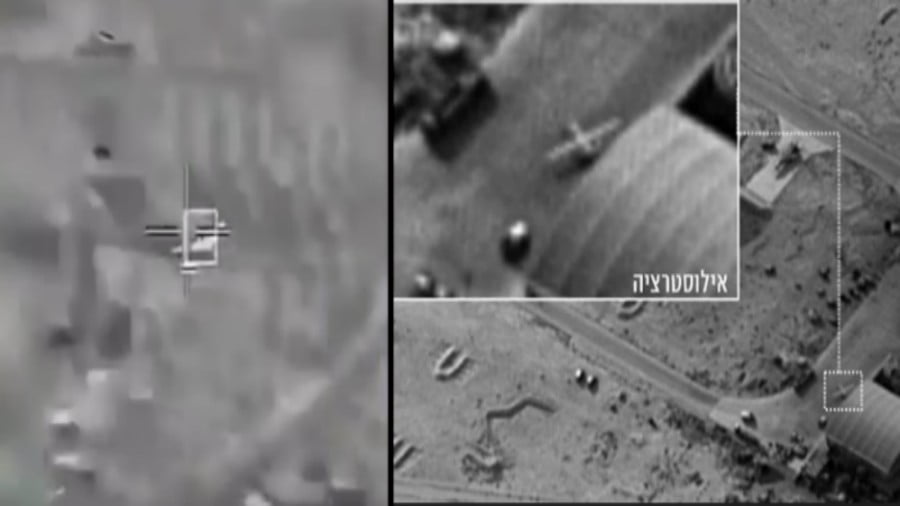Syrian Downing of F-16 and Related Israeli Fairy Tales
On 10 February 2018, an IAI’s F-16 was shot down by the Syrian Air Defense Force. According to the Israeli story, their aircraft was shot down during the reprisal operation against Iran-operated Syrian base, from where the Iranian drone took off the same day and made an incursion into Israeli territory. Allegedly, it flew along the Jordanian border and was intercepted by AH-64 Apache helicopter 90 seconds after crossing the Israeli border. It was destroyed by a missile, although not completely so they can study it. Israeli Army stated it was very likely armed with standoff weapons, and was allowed to cross into Israel to prove Iranian aggression. They also claimed the Iranian drone was sent to test if the Israeli air defense systems could detect a stealth drone, and test failed. What’s wrong with this story? Literally everything.
Starting with the claim about the “retaliatory” mission, we should remember this was not the first time that Israel is perpetrating airstrikes against targets in Syria. The first incident of this kind took place on 30 January 2013, when Israeli aircraft were striking a Syrian convoy. It continued in May 2013 with a series of aerial attacks made on targets at Damascus International Airport, Jamraya, and the Al-Dimas and Maysalun areas. In July 2013 anti-ship missiles stockpiles were targeted near the city of Latakia, and in another raid on October the attack happened at an air defense site in Snawbar. In 2014, another strike happened in Latakia on January, two airstrikes against facilities in Lebanon near the border with Syria on February, and a series of Israeli airstrikes struck Damascus on December.
In January 2015, Israeli helicopters attacked a convoy in the Syrian-controlled part of Golan Heights, killing six members of Hezbollah and six IRGC members, and some ten days later they opened artillery fire on Syrian border positions. There were new airstrikes against Syrian army in late April 2015, and in July Israeli airplanes struck a vehicle located in a Druze village in southwestern Syria. On 31 October 31, 2015, Israeli aircraft attacked numerous targets in southern Syria, close to the border with Lebanon in the Qalamoun Mountains region. Another Israeli airstrike near Damascus airport was reported on 11 November, and the Qualamoun region has been target again on 23 and 28 November. In late November 2016, Israeli jets attacked a Syrian military compound in Damascus, as well as a weapons convoy in the Damascus-Beirut highway, and in December Israeli surface-to-surface missiles targeted the Mezzeh airbase near Damascus.
Numerous of other Israeli airstrikes were reported in 2017 and 2018, which puts the total number close to forty. In all of those cases Israeli aircraft went unharmed, but now on the first occasion on which Israel lost a jet, the mission has been described as of “retaliatory” type. Does it really make sense? The reality is, Israel is conducting a war of attrition in Syria by helping rebels and terrorists, all in attempt of slowing Syrian military progress through continuous losses in personnel and material. Beside airstrikes, Israel is also helping the rebels in a variety of other ways, by providing arms, intelligence, medical care, and so on. After Syria achieved great military successes during the past few months, Israeli airstrikes also intensified. Terrorists today freely operate in the Southwestern along the border with Golan Heights, itself an Israeli occupied and annexed Syrian territory.
There are many other contradictions in Israeli reports about an “Iranian drone committing an act of aggression.” According to the footage released by the IDF, showing an Israeli AH-64 Apache helicopter downing an UAV, as well as photos of its remains, a drone appears to be an Iranian produced copy of the American RQ-170 that was shot down in Iranian skies in 2011 by Iranian forces. A very similar in shape but reduced in size, Iranian Saegheh drone was unveiled in October 2016, and it was ridiculed in the Israeli media as a worthless toy which can not even fly. Now, Brig. Gen. Tomer Bar, the Israeli Air Force’s second-in-command, says the Iranian drone was quite advanced and emulated Western technology. Still, even if we accept the story that a drone was Iranian-made, this does not imply Iran actually operated it. It could be an export model operated by the Syrian Arab Army.
In both cases, a drone was clearly conducting the aerial reconnaissance and it did not cause any damage. Without any doubt, it was not even armed, opposite to the Israeli claims. In late 2016 Iran did show two types of Saegheh drone, the first one unarmed and the second one armed with four rockets on the external hard-points. However, the weapon’s weight reduces a useful range of a drone, and more importantly, without internal weapon bays (like on F-22, F-35 or Su-57) its far more exposed to radar. Both Iran in 2011 and the USSR in 1960 downed American spy planes, and there was no talk about the act of aggression. If Iran wants to make an act of aggression against Israel, it can fire 1000 MRBM rockets within few hours. Or even worse for Israel, it can fire three per day during a year, keeping eight million of Israelis in shelters and their economy paralyzed. For Syria its even more easy since they have a massive artillery and they share a common border. Making an alleged act of aggression with four rockets loaded on a small drone makes absolutely no sense.
Between two contradicting stories of “carrying weapons” and “testing stealth,” the former one sounds more probably, but it is even more likely that its actually a cheap expendable drone that proved to be effective for the mission. It successfully spied and it cost enemy pretty much, since a single Stinger missile costs roughly $40,000. Clearly, the cost-exchange ratio is on their side. Israel has tried to negate its success by claiming it was shot down after a minute and a half in Israel’s airspace. In fact, it was downed over the city of Beit Shean, near the Jordanian territory, which means it spied more than 70 km of Israeli border, not to mention Jordan is also on Israeli side in the Syrian War. Another ridiculous claim by Israel is that they’ll recover and study the drone technology, while their photos show it totally destroyed. When the Iranian armed forces captured an American drone flying over Iran in December 2011, they showed an RQ-170 Sentinel almost intact and they have been able to decode footage obtained from it. Obviously, Israel does not have such capabilities.
Israelis also claimed a drone has been sent from the Tiyas Military Airbase (T-4 Airbase), and that Iran’s Quds Force of the Revolutionary Guards have been operating there for a long time, backed by Syrian army forces and with the approval of the Syrian government. Both Syria and Iran denied did, and so did Russia, a country which keeps friendly relations with Israel. To prove their point, Israelis embarrassed once again by publishing spy aerial imagery of “downed Iranian drone” in the T-4 Airbase, while even a kid can recognize their shapes don’t match at all (see photo above). Many equally laughable claims have been told about losing F-16 itself – it was allegedly targeted by “over 20 surface-to-air missiles,” and the twelve retaliatory air strikes “destroyed nearly half of Syria’s 900 launchers.” Americans did embarrass themselves with making excuses for losing U-2 over the Soviet Union and RQ-170 over Iran, but not this much. Some Israeli patriots admitted failure with bitterness, but still proudly asserting it was the first time Israel lost a jet to an enemy combatant since 1982. That’s correct, but only because they didn’t have any serious engagement and all operations were directed against enemies without air force or countries torn by war. For the same reasons, the German Luftwaffe scored zero losses against several Jewish ghetto uprisings.
By Marko Knežević
Source: Balkans Post







